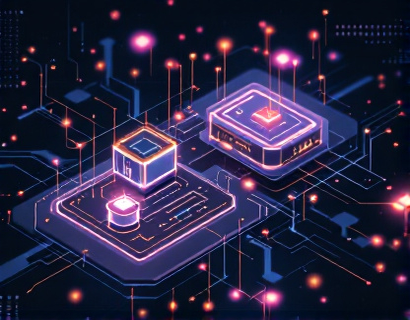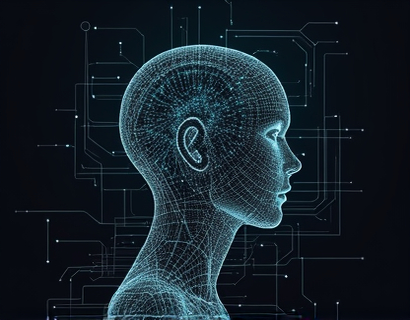Unlocking Digital Transformation: Harnessing AI and Crypto for Enhanced User Engagement in the Tech Ecosystem
The digital landscape is undergoing a profound transformation, driven by the convergence of artificial intelligence (AI) and cryptocurrency technologies. This convergence is not just a technological advancement but a paradigm shift that is redefining how businesses and users interact within the tech ecosystem. By leveraging the power of AI and crypto, organizations can unlock new levels of user engagement, drive innovation, and stay ahead in a rapidly evolving market.
Digital transformation is no longer a choice but a necessity for businesses aiming to remain competitive. The integration of AI and cryptocurrency offers a unique opportunity to enhance user experiences, streamline operations, and create new revenue streams. This article delves into the ways these cutting-edge technologies are reshaping digital experiences and provides valuable insights and strategies for leaders and innovators to harness their potential.
Understanding AI and Cryptocurrency in the Tech Ecosystem
Artificial intelligence, with its ability to analyze vast amounts of data, learn from patterns, and make decisions, is revolutionizing the way businesses operate. AI can personalize user experiences, optimize processes, and provide predictive insights that were previously unattainable. On the other hand, cryptocurrency, built on blockchain technology, offers a decentralized, secure, and transparent way to conduct transactions and manage assets.
The synergy between AI and cryptocurrency creates a powerful toolkit for enhancing user engagement. AI can leverage blockchain's transparency and security to build trust, while cryptocurrency can incentivize user participation and reward engagement. Together, they form a synergistic force that can transform the tech ecosystem.
Enhancing User Engagement through AI-Driven Personalization
One of the most significant impacts of AI in the tech ecosystem is the ability to deliver highly personalized experiences. By analyzing user behavior, preferences, and interactions, AI algorithms can tailor content, recommendations, and services to individual needs. This level of personalization not only improves user satisfaction but also increases engagement and loyalty.
For instance, AI-powered chatbots can provide 24/7 customer support, answering queries and resolving issues in real-time. These chatbots can learn from past interactions to offer more accurate and relevant responses, enhancing the overall user experience. Additionally, AI-driven content curation can ensure that users see the most relevant and engaging content, keeping them coming back for more.
Incentivizing User Engagement with Cryptocurrency
Cryptocurrency introduces a new dimension of incentives that can significantly boost user engagement. By integrating token-based reward systems, businesses can motivate users to participate actively in their platforms. These tokens can serve as digital currency within the ecosystem, allowing users to earn, trade, and redeem rewards.
For example, a social media platform could implement a token system where users earn tokens for creating and sharing high-quality content. These tokens can be used to access premium features, participate in governance, or even traded for fiat currency. Such a system not only encourages user participation but also builds a community around the platform, fostering a sense of ownership and loyalty.
Building Trust and Security with Blockchain
Trust and security are paramount in the tech ecosystem, and blockchain technology addresses these concerns head-on. The decentralized and immutable nature of blockchain ensures that transactions and data are secure and transparent. This transparency builds trust among users, who can verify the integrity of the system independently.
AI can complement blockchain by optimizing the management and analysis of data stored on the blockchain. For instance, AI algorithms can monitor blockchain transactions to detect anomalies or fraudulent activities, enhancing the security of the ecosystem. This combination of AI and blockchain creates a robust framework that users can trust, further enhancing engagement.
Creating Decentralized Marketplaces
The integration of AI and cryptocurrency enables the creation of decentralized marketplaces that operate without intermediaries. These marketplaces leverage smart contracts, self-executing contracts with the terms directly written into code, to facilitate transactions. AI can optimize the matching of buyers and sellers, ensuring efficient and fair transactions.
In such marketplaces, users can buy, sell, and trade a wide range of digital assets, from cryptocurrencies to NFTs (non-fungible tokens) and other unique digital goods. The decentralized nature of these platforms reduces costs and increases accessibility, making them attractive to a broader audience. AI-driven analytics can provide insights into market trends and user behavior, helping businesses to refine their offerings and strategies.
Fostering Innovation through Open Source and Community Driven Development
The open-source nature of many AI and blockchain projects fosters a collaborative environment where innovators can contribute and build upon existing technologies. This community-driven approach accelerates innovation and allows for rapid iteration and improvement.
By embracing open-source projects, businesses can tap into a global pool of talent and resources. AI frameworks and blockchain platforms like Ethereum provide the tools necessary to develop cutting-edge applications. This collaborative ecosystem not only speeds up development but also ensures that solutions are robust, secure, and widely adopted.
Strategies for Implementing AI and Cryptocurrency in Your Ecosystem
For organizations looking to harness the power of AI and cryptocurrency, several strategies can be employed to integrate these technologies effectively:
- Conduct a thorough assessment: Evaluate your current infrastructure and identify areas where AI and cryptocurrency can add value. Consider user needs, business goals, and technical feasibility.
- Start small: Begin with pilot projects to test the waters. This approach allows you to refine your strategies and address any challenges before a full-scale implementation.
- Invest in talent: Build a team with expertise in AI, blockchain, and cybersecurity. Continuous learning and upskilling are essential in these rapidly evolving fields.
- Focus on user experience: Ensure that the integration of AI and cryptocurrency enhances the user experience rather than complicating it. Simplicity and intuitiveness are key to successful adoption.
- Ensure compliance: Navigate the regulatory landscape carefully. Stay informed about laws and regulations governing AI and cryptocurrency to avoid legal issues.
Case Studies: Successful Integration of AI and Cryptocurrency
Several organizations have successfully integrated AI and cryptocurrency to enhance user engagement and drive growth. For example, a gaming platform implemented a token-based economy where players earn tokens for completing tasks and participating in the community. These tokens can be used to purchase in-game items or traded on a decentralized marketplace. The result was a highly engaged user base and a thriving community.
Another example is a content creation platform that uses AI to curate personalized content for users and rewards creators with cryptocurrency tokens. This dual approach has led to increased user retention and a vibrant creator ecosystem.
Future Trends and Opportunities
The convergence of AI and cryptocurrency is just beginning, and the future holds numerous exciting possibilities. As these technologies continue to mature, we can expect to see more sophisticated applications and broader adoption across various industries.
One emerging trend is the integration of AI with Web3 technologies, which build on blockchain to create decentralized web applications. This fusion can lead to more autonomous, user-centric, and secure digital experiences. Additionally, the rise of decentralized finance (DeFi) and non-fungible tokens (NFTs) presents new opportunities for businesses to innovate and engage users in novel ways.
Another area of growth is the use of AI for blockchain optimization. AI can help manage blockchain networks more efficiently, reducing congestion and improving transaction speeds. This synergy can make blockchain-based solutions more practical and appealing for widespread use.
Conclusion
The integration of AI and cryptocurrency is transforming the tech ecosystem, offering unprecedented opportunities for enhancing user engagement and driving growth. By leveraging these technologies, organizations can create more personalized, secure, and incentivized experiences that resonate with users. As the landscape continues to evolve, those who embrace this convergence will be well-positioned to lead the charge in digital transformation.










































